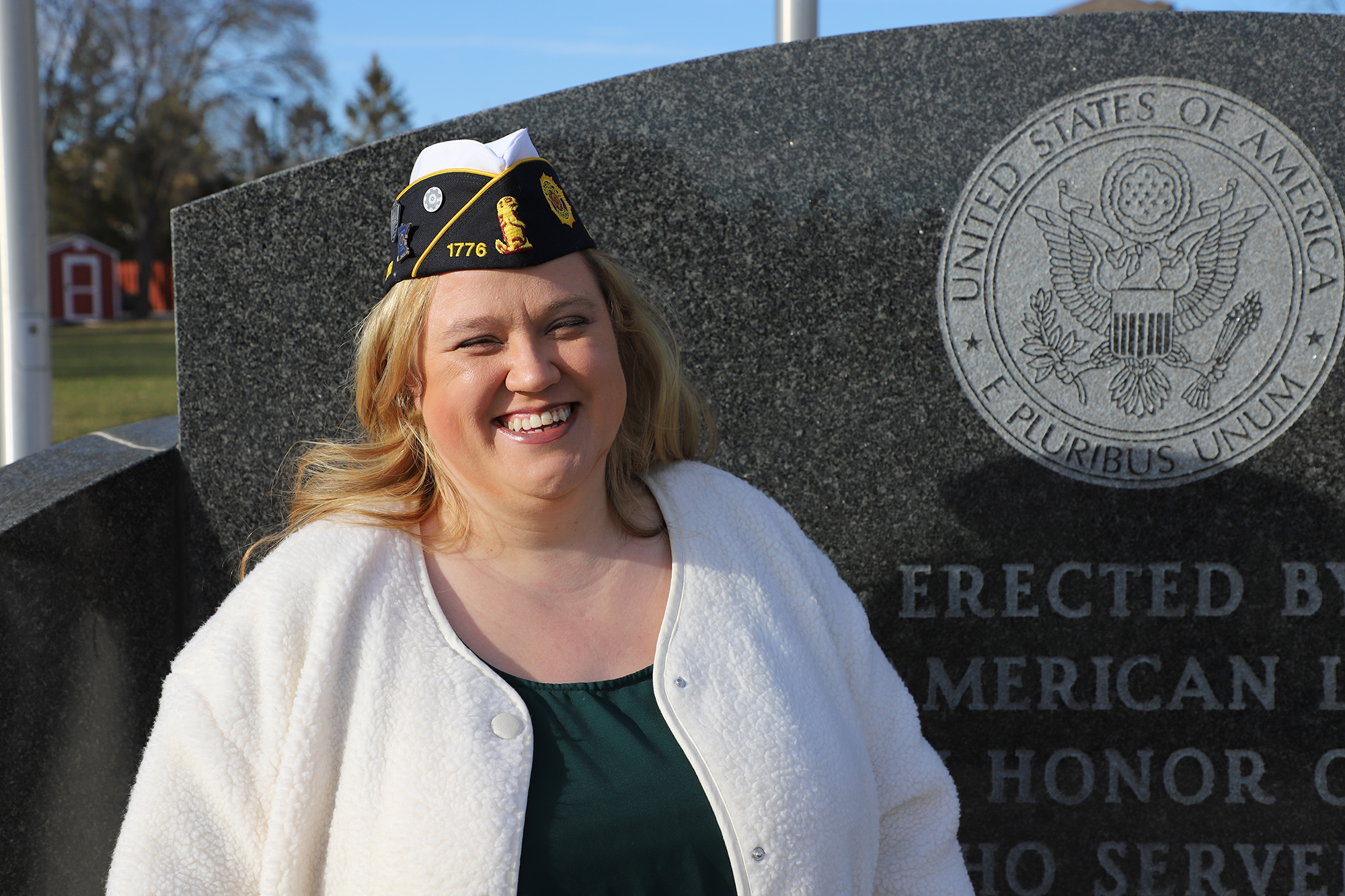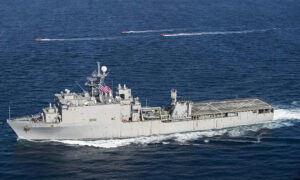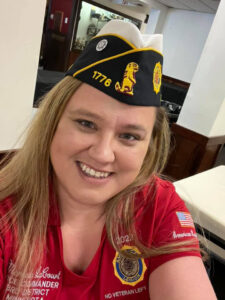
By Tim Engstrom
The Minnesota Legionnaire
APPLE VALLEY — The Minnesota Legionnaire has told countless stories of veterans who were wounded while in service to their country.
But not all wounds are visible.
Here is one such story of a mother of three from Farmington who, when she served in the U.S. Navy, suffered through weeks of sexual assault by her supervisor while at sea, and she could do nothing about it.
“The thing I hope everyone understands is that, when you are on the ship, those COs have all the power. If they don’t want to protect their sailors, they don’t have to. That’s the thing that needs to change.”
Marissa LaCourt, 35, calls for the Navy to implement a central reporting system like the Marines and Air Force have and like the Army, as of October, is overhauling.
How does military sexual trauma happen? Read on, because LaCourt isn’t afraid to tell her story:

Marissa LaCourt graduated from high school in Vernal, Utah, in 2004, only her last name was Morton back then.
She attended the University of Utah for half a semester, then left because she was unsure of a career path. She tried being a flight attendant for Chautauqua Airlines before working two or three minimum wage jobs and couch surfing in Salt Lake City.
“Then I stumbled upon a Navy recruiter at a frat party,” she said.
It was 2006. He had given her his business card, and she walked into the recruitment office that Monday. Next it was the ASVAB test, then MEPS. Six weeks later, she was at boot camp at Naval Station Great Lakes in Illinois.
Her nickname at basic was “Princess” because she was the only one who joined to join. Others were escaping financial woe: teen motherhood, foster upbringing, only option left, things like that.
Navy drill instructors are called RDCs, for “recruit division commanders,” and LaCourt’s RDCs told her, “Every single one of these people are rooting for you to fail.”
She passed and went on to A School, which is the nickname for Accession Training. It’s where the Navy teaches recruits their job skills. LaCourt went to the Engineman A School and became a diesel mechanic.
She admits she wasn’t a good mechanic.
“I at least tried to be good at it.”
The Navy sent her to the USS Pearl Harbor, a landing dock ship that can transport amphibious craft, vehicles, landing craft and crews. The Pearl Harbor is based out of Naval Station San Diego.
The diesel mechanics worked down in “The Hole,” the engine room down at the bottom of the ship.
There aren’t many women who serve as diesel mechanics.
“They told me if I was a problem I would be sent away,” LaCourt said.
The five male sailors in The Hole were good to her, she said, and they functioned as a team. Six months later, only two of the original team of six were left: LaCourt and a sailor with the last name of Brewer.
What happened to the others: One thing or another, such broken hip, transfer to another part of the ship, so on.
The Pearl Harbor was going to Pearl Harbor for Pearl Harbor Day. She was part of group of sailors who, in a boat, took survivors of the 1941 attack on Pearl Harbor to the middle of the harbor.
She was on this craft with six survivors for an event held by The American Legion.
“It was this cool, amazing experience,” she said.
She met Ross LaCourt, a Marine stationed at Camp Pendleton, when his amtrac clipped a fuel line and spilled hundreds of gallons of fuel. She helped with the cleanup, and the Marines sat and watched, jokingly telling the sailors they missed spots.
Mutual friends of theirs began dating, and Ross and Marissa ran into each other and eventually dated. Ross is from Marinette, Wis. They didn’t have a big, fancy wedding. They got married in the backyard of some lady from Carlsbad, Calif.
Ross asked Marissa, “What are you doing Saturday?”
“Nothing,” she replied.
“Great. We are going to get married.”
Their parents threw a fit. They had to throw a second marriage later on in Las Vegas after he returned from Iraq.
The Navy and Marine Corps kept them stationed together — San Diego and Pendleton.
LaCourt and Brewer, who went to boot camp and A School together, were busy in The Hole when the Pearl Harbor deployed in 2007. The ship left San Diego and went through the Panama Canal. It was headed around Cape Horn and into the Pacific Ocean, but LaCourt had to leave the ship during a stop in Brazil.
She was pregnant.
She was excited about having a baby but heartbroken about leaving the USS Pearl Harbor during “the deployment of my dreams.”
LaCourt went to San Diego, became a petty officer and worked with security forces on North Island. She had an office and a small team.
“They had a lot of faith in me,” she said.
During this time, she gave birth to a boy, Zachary, who today is a well-known 13-year-old at Apple Valley Post 1776.

LaCourt even helped coordinate a presidential visit. Her team spent three months preparing for President Barack Obama’s seven-minute stop at the island’s tarmac.
She liked the job, but pregnancy, she said, left her cranky and tired. Shore duty lacked the same camaraderie found on the Pearl Harbor, and she was bummed about not completing a tour at sea. For a year, she attended schools with the hopes of returning to sea.
She went aboard the USS Decatur, a guided-missile destroyer named for a commodore from the Quasi-War, the Barbary Wars and the War of 1812.
“They told me this is where an engineer wants to go, but it probably was one of the biggest mistakes I made in my life,” she said.
LaCourt said the sailors aboard the Decatur lacked camaraderie and hustle, like she had witnessed on the Pearl Harbor. The Decatur was powered with four gas turbines and had no need for a diesel mechanic, so she worked with the auxiliary services shop, doing jobs on the ship that don’t have a trained staff to handle.
She was the lowest ranking sailor in her shop and the only female. She was E-4, and everyone else was E-6 or higher.
“Just by being there, I was looked at as a problem, not somebody to teach or learn,” LaCourt said.
You can guess how this turns out. The higher-ranking petty officers made LaCourt do all the jobs they didn’t like or were too lazy to handle, such as sewage detail or climb a four-story ladder.
“It got to the point where it didn’t really bother me,” she said.
In 2009, the Decatur headed out on a six-month deployment called WESTPAC, jargon for Western Pacific. They left for Japan, then to Singapore and on to the Arabian Sea and the Persian Gulf.
“Nobody talked. There was no brotherhood. I never felt more alone,” LaCourt said. “We were going along the coast of Japan when we had a sailor jump overboard.”
She said shipmates generally were afraid to ask whether there were signs of suicide. They generally agreed nobody would have done anything to stop it anyway.
“Nobody made waves. It was: ‘Just keep your head down and do what you need to do.’”
Shipmates knew the independent-duty corpsman didn’t like to file paperwork, and the CO didn’t want to act.
“I had never met a CO who had a closed door before,” LaCourt said.
The XO was the same way, and the Decatur had no chaplain to approach.

Then things started getting strange in the auxiliary department. The chief petty officer, an E-7 married man she calls “Chief,” started paying extra attention to her. One red flag came at a weigh-in and tape-in after passing a physical fitness test.
The Navy doesn’t allow men to tape and weigh women, but Chief did it anyway. LaCourt didn’t want to make waves and ignored the red flags.
A petty officer first class (E-6) grabbed her and said, “I don’t know what you two have going on, but it needs to stop.”
She replied, “I don’t know what you are talking about.”
Chief began tinkering with her liberty — free time allowed off-ship while in port. He said he didn’t want her to get in trouble. She told him she had never been in trouble before. He said he didn’t trust her. He also limited her movement around the ship.
“These actions came days before he began assaulting me. It was this control thing,” she said.
LaCourt had no one to turn to. The independent-duty corpsman wouldn’t act. She reported it to a master chief petty officer (E-9), and he said, “Just go back to work. You’re being dramatic about it.”
Not facing repercussions, Chief escalated his sexual assaults on LaCourt.
“I was told if you report it or say a word, you can be the next guy to fall overboard,” she said.
She couldn’t send an email or place a phone call. Those are monitored, and she was in fear of being punished for calling out for help. Here she is, stuck out in the Arabian Sea, being raped multiple times by her supervisor and there’s nothing she can do about it.
“It was three weeks of living hell, constant assault, until I finally got the chance to say something. I remember counting the Sundays, watching the tanks thinking we have to go in for fuel.”
Days blend together, but Sundays on the ship had less work and more free time, giving Chief more opportunity, so she made sure to hide.
“I remember going to the worst places of the ship to read a book. I would go down to the VCHT pumps, where the sewage is processed, because nobody would find me down there. No one did find me down there. It smelled. It was hot. It was gross, but nobody bothered me.”
Finally, the Decatur was heading to Bahrain for a week in port. On the first day, LaCourt volunteered to do fuel intake, because Chief wouldn’t be able to prevent her from being off the ship for that short time.
While off, she stopped a gate guard, a master-at-arms, who are the Navy’s MPs.
“I told him, ‘Hey, I need help. I am on this ship. This is my name.”
Six days passed. Nothing happened. The USS Decatur returned to sea.

“I feared all of this abuse would continue, but that gate guard did come through.”
After three days at sea, a helicopter showed up and requested LaCourt for an exam aboard the USS Ronald Reagan, which was back in Bahrain.
It was an excuse to get LaCourt off the ship without raising suspicions of the Decatur crew. They thought it had something to do with an OBGYN doctor. In reality, the Navy was taking her stateside.
On the Reagan, she met two women from the Decatur who were not receiving their depression medication or any related support. One of the two had cut marks on her wrist.
On the Decatur, the independent-duty corpsman knew what was up and made sure to protect himself. He sent a letter to the ship’s medical officer saying LaCourt was hysterical, failed to adapt to new circumstances, a violent human being, delusional and a had a high risk of suicide. He filed paperwork to put her on a 72-hour suicide watch.
That resulted in the Navy putting her in a mental ward aboard the Reagan and in San Diego.
“It’s not really the best place to be when you are not crazy. You are force-fed drugs and have to talk to therapists about, ‘Why do you want to kill yourself?’ and you are like, ‘I don’t.’ You almost have to prove you are not suicidal.”
Later, back in San Diego, Chief was put in a room and had to explain himself. He claimed the sexual acts were consensual. He claimed LaCourt was upset due to him wanting to end the sex because he was married. He said she threatened to kill herself, so that’s why they separated her from the ship in accordance with the Uniform Code of Military Justice.
After hearing this, she was facing charges of lying and malingering.
“I kind of went into survival mode and aired it all out,” LaCourt said. “I told the whole story. I’m not going down without a fight. I’m not losing my Navy career because of one man.”
She had to face questions from a panel that had nothing to do with the case, such as “How many men have you slept with in your life?”
She explained she doesn’t hide her marriage to Ross and couldn’t understand why Chief violated his own marriage vows.
“This man met my husband, met my child, has been in my home,” she said. “To me, marriage is forever. You are committed to one person. That’s it.”
Chief even brought his wife and children to court.

The case became a he-said-she-said war. The Navy ended up finding Chief not guilty, and he retired with full benefits. The ship was found not negligent.
LaCourt moved on, enjoying her life with her husband and son. She thought it was over.
It wasn’t.
The Navy sent her to the Southwest Regional Maintenance Center, or SWRMC, in San Diego. The old command told her new command, and she was labeled a “shitbag sailor,” she said.
They treated her as a liar and had a dark impression of her from the beginning.
One difficult aspect of falsely being placed on suicide watch is always having to convince medical staff you are not a mental health risk. Another is the new command is examining the sailor for any signs.
“Everything is scrutinized, such as having your hair slightly out of place, like after a run. If you show up not looking perfect, it’s one of the flags they are looking for,” LaCourt said. “It’s not the best way to live. You can’t have an off-day.”
The Navy labeled her bipolar, and she spent five years getting the Navy and then the VA to remove the bipolar assessment and get evaluated for PTSD. Even then, the VA doctor said she was manic depressive.
“Only a year and a half ago did they change it to PTSD due to MST while in military service,” LaCourt said.
She said she learned from American Legion Department of Minnesota Service Officer Jeremy Wolfsteller that PTSD doesn’t just go away. Sufferers have to work on it, even learn to live with it.
She called Wolfsteller “phenomenal” and said she has taken what she has learned from PTSD and put it toward being a good mother, to give herself grace and to give back by being a Legionnaire.
Three months into the new duty, her old first-class petty officer from the USS Pearl Harbor made senior chief and reported to SWRMC.
“He found out about the rumors and said, ‘No, I know that girl. She’s actually stellar,” LaCourt said.
Meanwhile, her assailant from the Decatur, now stationed in San Diego, found out she was at SWRMC, and he would show up at her new workplace to remind her that nobody would believe her and she needed to keep her mouth shut.
The command master chief at SWRMC wouldn’t stand for her former chief coming around, so he had security blacklist him.
What happened to him? His wife divorced him. One daughter, who had been in that courtroom when she was 8, won a college full-ride scholarship for an application video she made about how her loving father was someone else’s monster.
LaCourt spent some time as a Navy career counselor, and when she was close to separation, she became pregnant with fraternal twins, giving birth to daughter Annie and son Nick. She left the Navy in 2012.
In 2017, Ross was stationed at Fort Snelling supporting Marine reservists, and that brought them to the Land of 10,000 Lakes. She worked civilian jobs and got a bachelor’s degree in human resources while he provided commo for a law-enforcement battalion.

For the past six months, Ross has been stationed at Camp Pendleton, while Marissa and the kids remain in Minnesota. He has 2 1/2 years left in the Marines before retirement. They are both members of Apple Valley Post 1776. She attended Minnesota American Legion College at Camp Ripley in April 2021, where she met then-National Commander Bill Oxford.
She knows people will read this story and say: She could have done this. She could have done that. She’s fine with criticism. She knows none of those critics were there. She has played out in her head what she could have done or the red flags she didn’t see, and she knows the story turns out the same.
“My story is one of millions. When I went to therapy, I was hoping I would be alone, but there were many. My story was actually one of the less violent ones.”
She continued: “There was one girl that I don’t know how she didn’t throw herself off the side of the ship, and there were multiple girls going through it on her ship.”
Military sexual trauma is not a diagnosis
According the VA healthcare system’s “Military Sexual Trauma Fact Sheet,” about one in three women and one in 50 men respond “yes” that they experienced MST, when screened by their VA provider.
Most victims of MST do not report it for fear of retaliation, and about 60 percent of cases lead to no conviction.
About 53 percent of homeless female veterans are MST victims, according to the National Center on Family Homelessness. It also says female veterans are two to four times more likely to be homeless than male veterans.
MST can range from forcible sexual assault to sexual harassment. It is not considered a diagnosis or mental health condition so much as an experience a servicemember goes through. Resulting difficulties arising from MST can vary based on the severity and duration of the experience.
The American Legion has passed several resolutions and worked as a partner with the VA to address and emphasize MST and its resulting impacts on veterans.
The VA provides free, confidential counseling and treatment for veterans’ mental and physical health conditions resulting from MST in active duty or, if it was in the National Guard or Reserve, training.